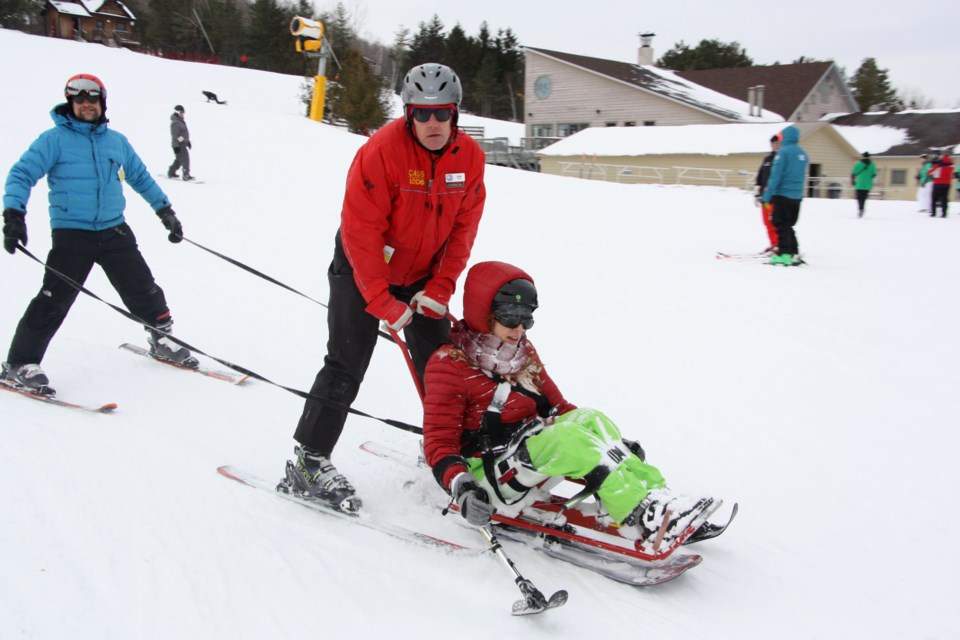At Craigleith Ski Club, a former ski instructor sat in a bucket seat while two volunteers attached various straps and clips to lock him into the seat.
Once Jake Thomas was securely inside the sit ski, those volunteers helped him onto the chairlift, and held tight to the guide straps to lead Thomas in a zig-zag down the hill.
Despite the buckles and straps, Thomas called the experience a moment of “escapism.”
“It was amazing to have the freedom again,” said Thomas.
He was a ski instructor for 20 years. Not accustomed to getting help, but being the helper. Until a car crash in 2017 left him with a spinal cord injury and rendered him a paraplegic.
In 2018, the 45-year-old Sudbury resident travelled to Blue Mountain to try skiing again. This time in a sit ski.
“When someone sustains a spinal cord injury, they have to come to terms with their own reality,” said Thomas, adding he has to learn to ski again, even after a lifetime on the hills.
“I’m pretty content with everything I’ve achieved in my life so far, but there were things I wanted to do with m kids, like skiing holidays in Vermont.”
He returned to the mountain this year for the annual Spinal Cord Injury Ontario ski and snowboard day at Craigleith Ski Club. It’s a fundraiser for the charity organization, but it’s also a chance for those with spinal cord injuries to try assisted skiing.
Thomas tried for the first time last year, but hadn’t been back on the hill since. This year, he returned with an interest in trying different equipment and learning more about the mechanics of adaptive skiing.
“Wheelchairs are confinement,” said Thomas, adding adaptive sports like skiing give a person who has a spinal cord injury “perpetual motion.”
“It gets you off your butt, and gives you a target,” said Thomas. “I’m going to learn to ski again so I can go out with my kids. They can help me on and off the chair like I did for them when they were little.”
He has also become an advocate for adaptive water sports as a member of the Water Ski and Wakeboard Ontario board of directors.
“Any young injured person has the ability to jump on [an adaptive sport] and make it their own,” said Thomas, adding the keyword in adaptive sports is “adaptive.”
“In traditional skiing, there’s a technically correct way to ski,” he said. “In adaptive skiing, anything goes. You just get down the hill safely and in control … you tweak the equipment, you figure out how your body can make the movements. You make the sport work for you.”
But at $4,000 to $10,000 for a sit ski, and the (literally) steep learning curve involved with downhill adaptive skiing, it’s overwhelming to experiment in the sport.
That’s where Spinal Cord Injury Ontario comes in.
CEO Stuart Howe said the organization’s aim is to help people with spinal cord injuries live the life they choose. They do that by providing opportunities like adaptive snowsports, and through peer support.
“We match people who have had injuries for a number of years with those who have just been injured,” said Howe. They will also make an effort to match people close in age and who might be going through similar life events. “Really, it’s people helping people.”
The annual ski and snowboard day at Craigleith Ski Club took place yesterday (Feb. 14) and was the 19th year for the event. The organization has raised $1.3 million at the event over the past 18 years. This year’s sold-out event saw 236 people attend. The day also includes help from Track 3 and Canadian Adaptive Snowsports volunteers, both organizations work with adults and youth in competitive adaptive snowsports.
For Howe, it’s an event he looks forward to each year, because it’s a chance to see the work of the charity in action.
“The biggest reason … is the smile on the face of someone as he or she reaches the bottom of the hill on a sit ski,” said Howe. “That’s what it’s all about.”
He said there are 30,000 people in Ontario living with a spinal cord injury, and there’s an average one injury per day occurring.
“We work with them from the time of the injury, through rehab, and back to independence,” said Howe. “Many of them come back and engage in advocacy or peer support work.”
Spinal Cord Injury Ontario was founded in 1945 by a group of Second World War veterans with spinal cord injuries. Those veterans began the charity as a way to advocate for improved services and assistive devices for those living with spinal cord injuries.
For more on Spinal Cord Injury Ontario, click here.
